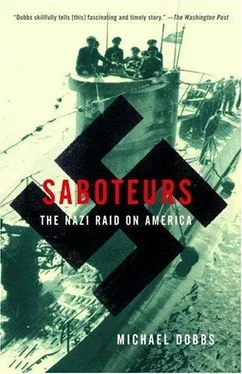The first map showed the locations of aluminum and magnesium plants along the eastern seaboard, marked with blue and red crosses. Several of the crosses were clustered around the town of Alcoa, Tennessee, center of the American aluminum industry and site of the largest aluminum plant in the world. Kappe explained that aluminum was the basic material in the construction of modern aircraft: its outstanding property was its light weight, roughly one-third that of steel. He pointed to a graph that showed that American aluminum production had increased from under 300,000 pounds in 1937 to more than 600,000 by 1941. The 1942 target was 1.2 million pounds. If the saboteurs could cripple or severely disrupt aluminum production, they might be able to prevent the United States from ever developing an effective air force to fight the Luftwaffe. 50
Disrupting aluminum production was simpler than it sounded. The process for manufacturing aluminum—invented by a young American chemist named Charles M. Hall in 1886—was heavily dependent on the supply of huge amounts of electricity. In fact, aluminum was formed through a process known as electrolysis, a kind of electric bath in which aluminum oxide was dissolved in melted cryolite ore. If the power supply was interrupted for long enough during this procedure, the molten metals would congeal, wrecking the stoves and baths in which the aluminum was manufactured. By downing critical power lines for a period of eight hours, saboteurs could permanently disable an aluminum plant.
An American pamphlet produced at the beginning of World War II summarized what was at stake in a neat formula:
Electric power → aluminum → bombers → victory. 51
It was the task of the Nazi saboteurs to reverse this formula:
Sabotage of power lines → less aluminum → fewer American planes → defeat.
Kappe assigned the job of attacking aluminum plants to group number one, which would consist of Dasch, Burger, Schmidt, Quirin, and Heinck. Dasch, at least, already understood the importance of aluminum to the war effort, and America’s ability to vastly increase its production of war matériel. Back in January, while still working at the foreign broadcast monitoring center, he had jotted down U.S. war production plans announced by Franklin Roosevelt in his State of the Union address to Congress. According to Roosevelt, America would increase its production of planes from 60,000 a year in 1942 to 125,000 in 1943.
“Kids, this war has not even begun,” Dasch warned his friends. 52
If there was any time left over from these activities, Kappe suggested several targets of opportunity, such as planting small explosive devices in Jewish-owned department stores or in the baggage-claim rooms of large railroad stations. The idea was not to kill and maim, he emphasized, merely to spread panic.
Group two, Kappe announced, would be made up of Kerling, Haupt, Thiel, and Neubauer. Their primary objective would be the transportation system. He turned the floor over to his assistant, Reinhold Barth, a former employee of the Long Island Rail Road, who produced maps of the American railroad and canal systems and photographs of critical bottlenecks such as the Hell Gate Bridge, connecting Long Island to the Bronx, and the great Horseshoe Curve of the Pennsylvania Railroad. Putting the Hell Gate Bridge out of action should not prove too difficult, Barth insisted. It was constructed out of metal plate rather than cast iron.
Kappe and Barth had done their homework. Among the targets they selected were two cryolite processing plants in Pennsylvania, which produced the aluminum oxide used to produce aluminum. The U.S. War Department had given the cryolite plants a P-3 classification, indicating a relatively minor importance for national defense. A subsequent investigation by American military intelligence showed that destruction of the two plants would practically halt aluminum production throughout the United States. The director of the Federal Bureau of Investigation, J. Edgar Hoover, would later comment that the German High Command was “better informed as to the importance of these two plants to our war production than was the United States Army.” 53
Because of difficulties in arranging U-boat transportation, Kappe had decided to grant the men two weeks’ furlough, to allow them to say goodbye to their families. Before they left Quenz Lake, however, there were a couple of personnel matters to be addressed.
The rumors about Burger’s problems with the Gestapo were true, Kappe said. But he repeated what he had already told Kerling: Burger was working toward his political rehabilitation and deserved their support. Besides, Kappe had special plans for the former concentration camp inmate. 54He wanted Burger to establish himself in Chicago either as a draftsman or as a violin teacher: he had talents in both directions. After renting a studio, he would signal to the spymasters back in Germany that all was well by taking out an advertisement in the Chicago Tribune . Burger’s studio would serve as a point of contact for subsequent sabotage groups arriving in America.
Kappe also confirmed the appointment of Dasch and Kerling as group leaders. Schmidt and Quirin were aghast at the choice of Dasch, and could not understand why Kappe had so much confidence in the garrulous former waiter. Privately, they talked about killing Dasch if he didn’t change his attitude by the time they reached America. When speaking to Kappe, they were more diplomatic: how should they deal with someone who proved untrustworthy?
This time, Kappe told the saboteurs what they wanted to hear. If there were grounds to suspect anyone of betraying Operation Pastorius, he replied, that person must be removed, if necessary by force. 55
CHAPTER TWO
FAREWELLS (MAY 1–21)
MOST OF THE MEN spent the furlough with their relatives. Peter Burger helped his wife move out of their small apartment in Berlin to his parents’ home in Bavaria. Dasch visited his parents in Speyer, in southern Germany; Quirin and Heinck returned to the Volkswagen plant in Braunschweig, where their wives and children were living in factory-supplied housing; Kerling went back to his family home in Wiesbaden.
Herbie Haupt took a train to the Baltic port of Stettin to visit his grandmother, who had given him a place to live after his around-the-world adventures. Having been in the United States as recently as June 1941, he was taken aback by the austerity and paranoia of life in Nazi Germany. From the land of plenty, he had arrived in a country where everything was rationed, and people had to make do with two cigarettes a day. He learned how to smoke the cigarettes down to a butt of a quarter of an inch and extract the remaining tobacco to put in a pipe. Fuel was in such short supply that his grandparents only heated one room of their house, and spent most of their waking hours there. Haupt resented the frequent visits from Gestapo officials checking up on the suspicious German-American. He “counted the days and hours” until he got back home to his family in Chicago. 1
The food shortages seemed to get more severe as the war progressed. At the sabotage school on Quenz Lake, Haupt and his fellow trainees had been relatively well fed, eating meat or some kind of stew four or five times a week. Much greater sacrifices were required of ordinary civilians. The official weekly ration per person was ten ounces of meat, four and a half ounces of butter and margarine, three ounces of cheese, three pounds of potatoes, and three-quarters of a pound of sugar. Eggs were only distributed at Easter, Christmas, and other special holidays. Frequently, food supplies were so tight that shops were unable to sell customers even their official rations.
Most of the men did not tell their families where they were going. Some invented cover stories, saying they were being drafted into the army. Others said they were being sent on a mysterious top-secret mission. The most candid was Burger, who told his wife he was going to America, but not what he would be doing there. As a communication system, he instructed her in one of the methods of secret writing he had learned at sabotage school. He also gave her a password to authenticate a message sent through a trusted intermediary. 2If someone introduced himself to her with the password, she was to immediately follow that person’s instructions.
Читать дальше












